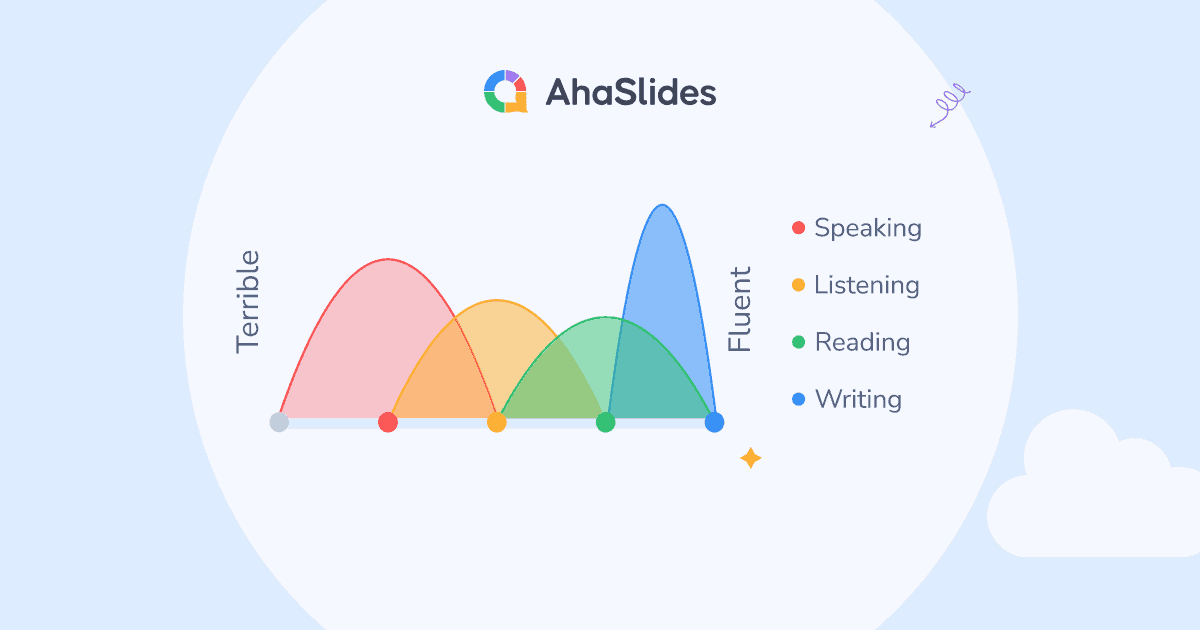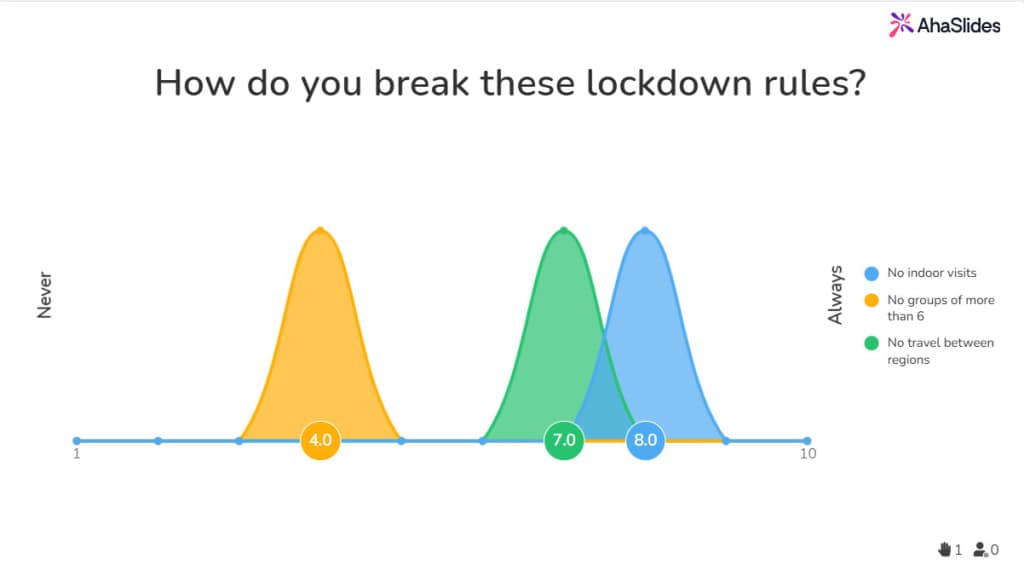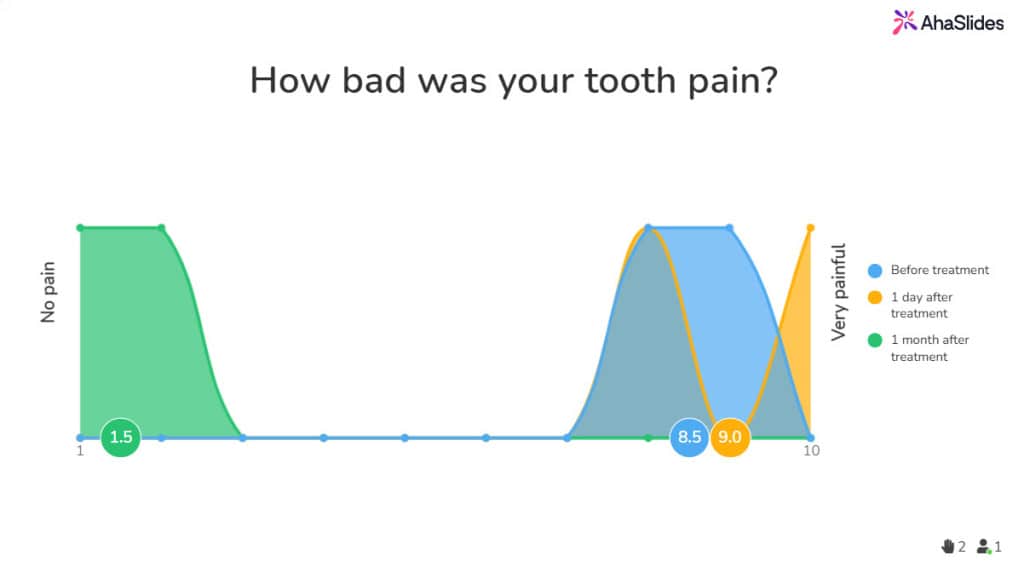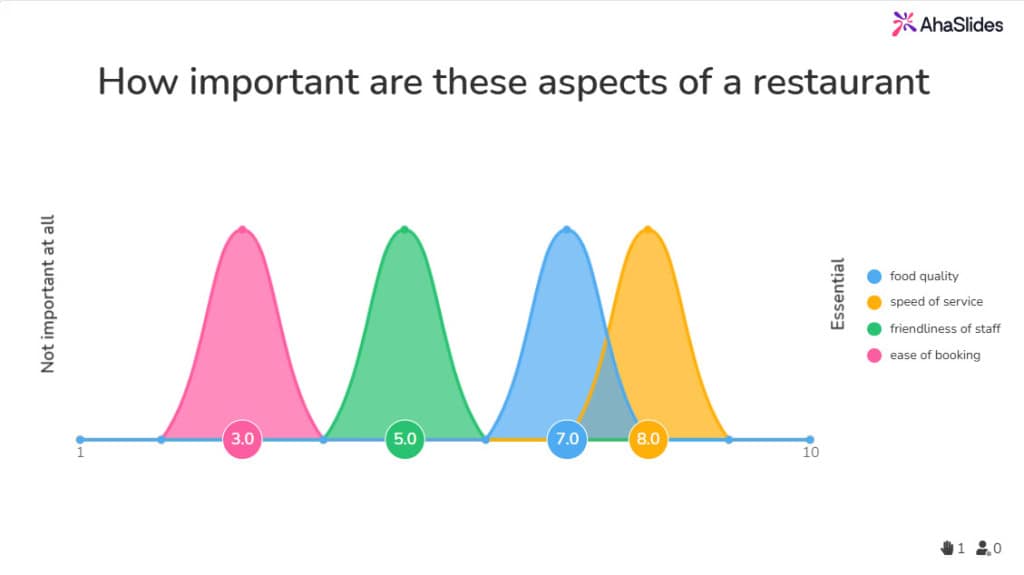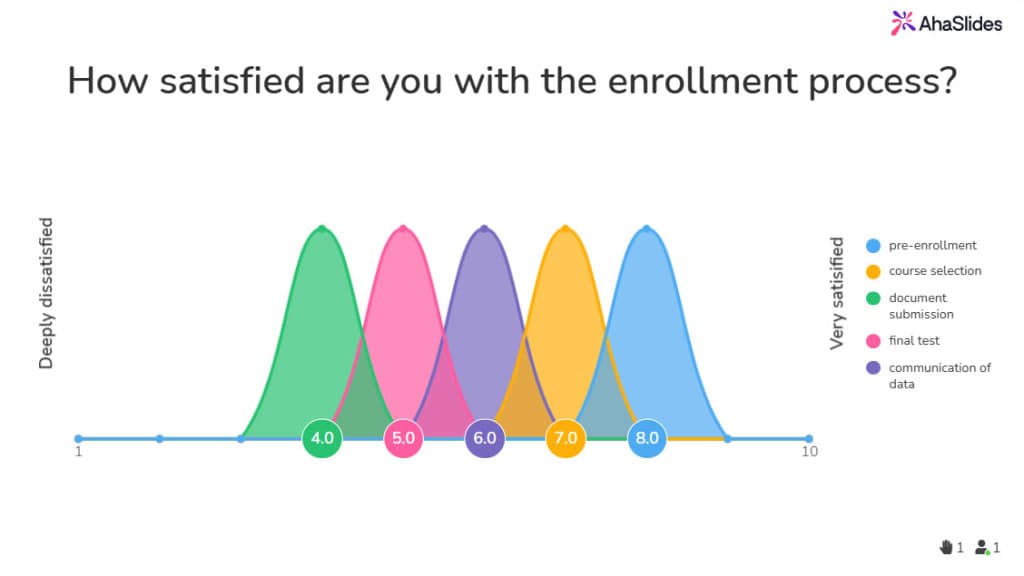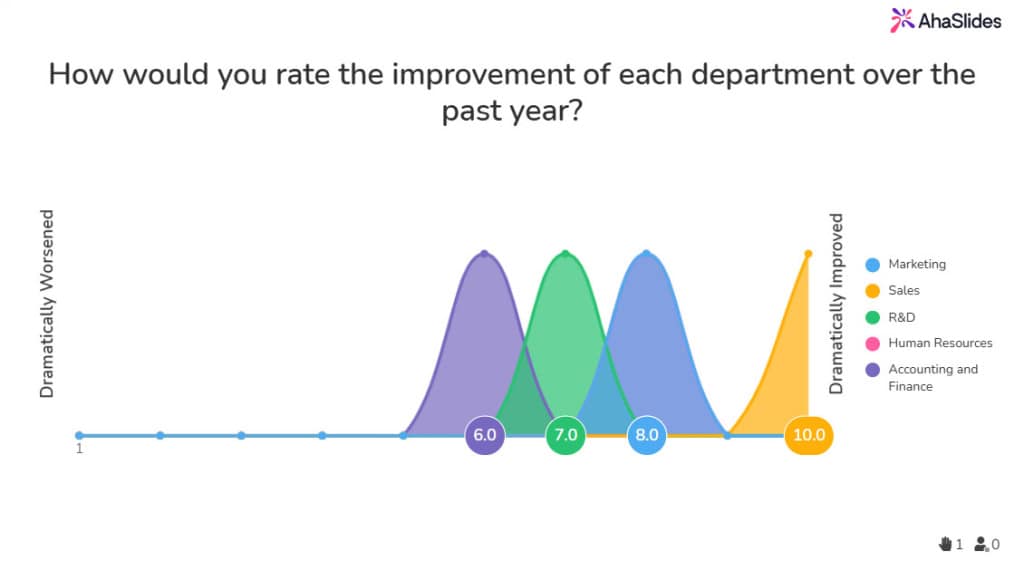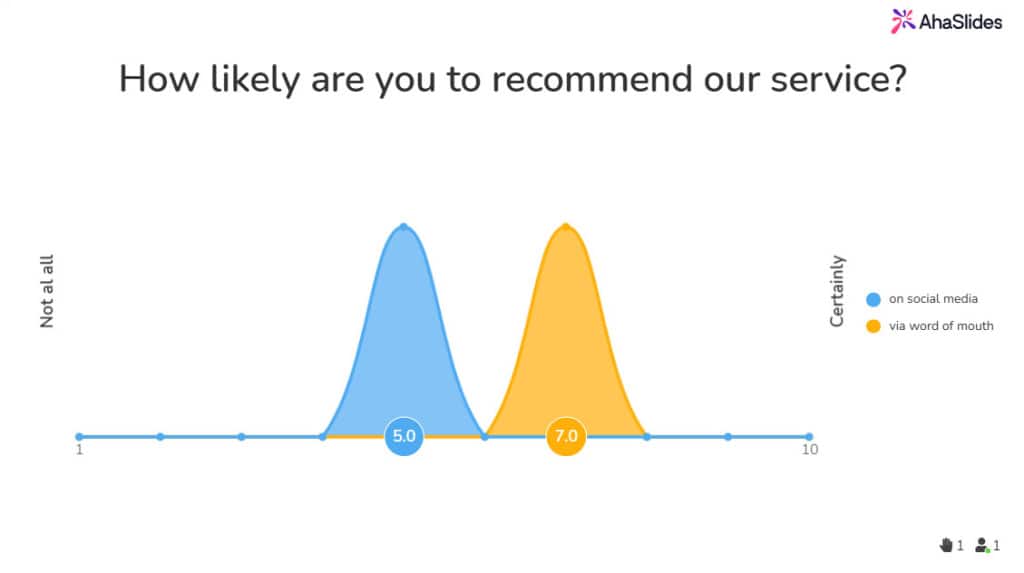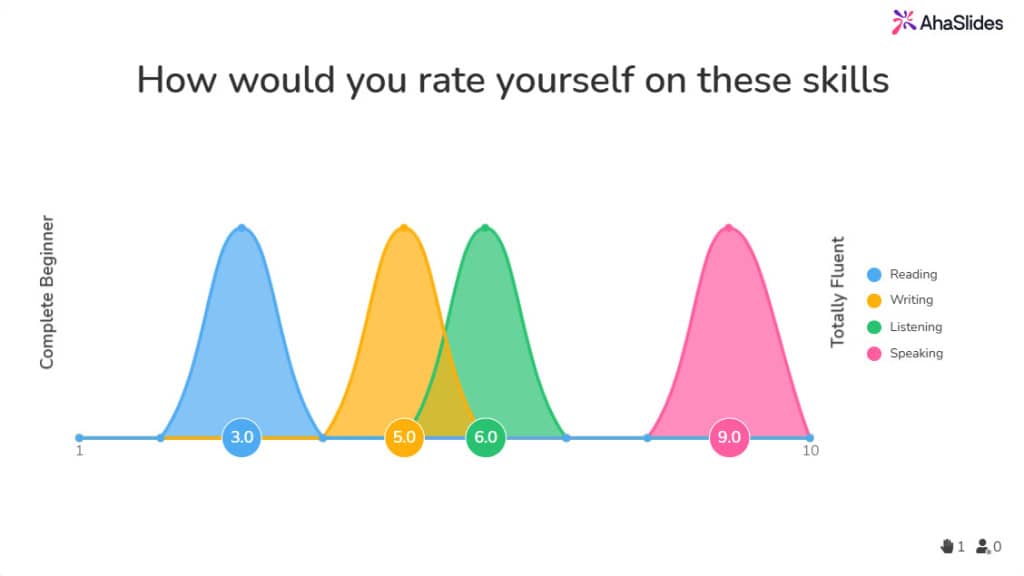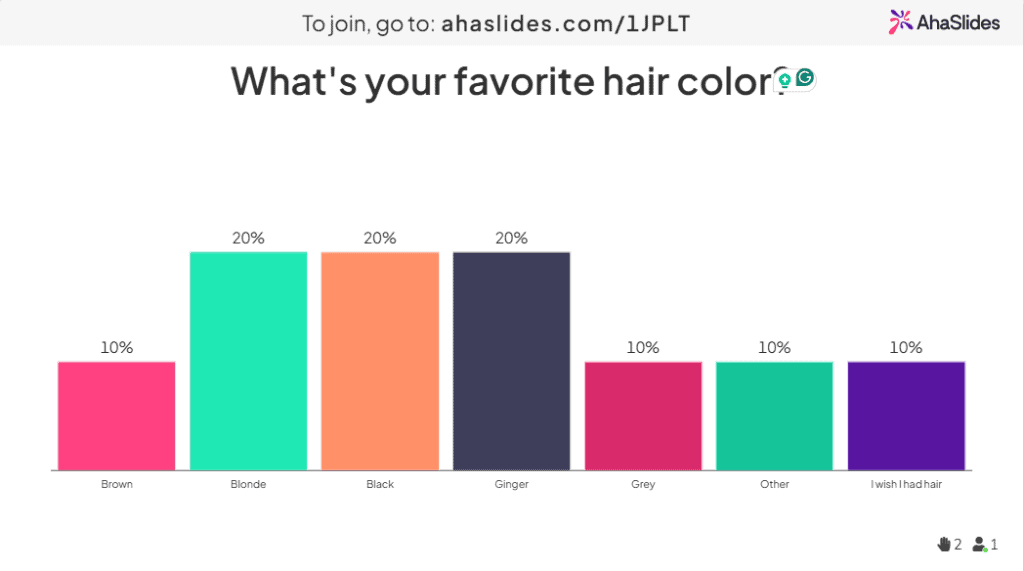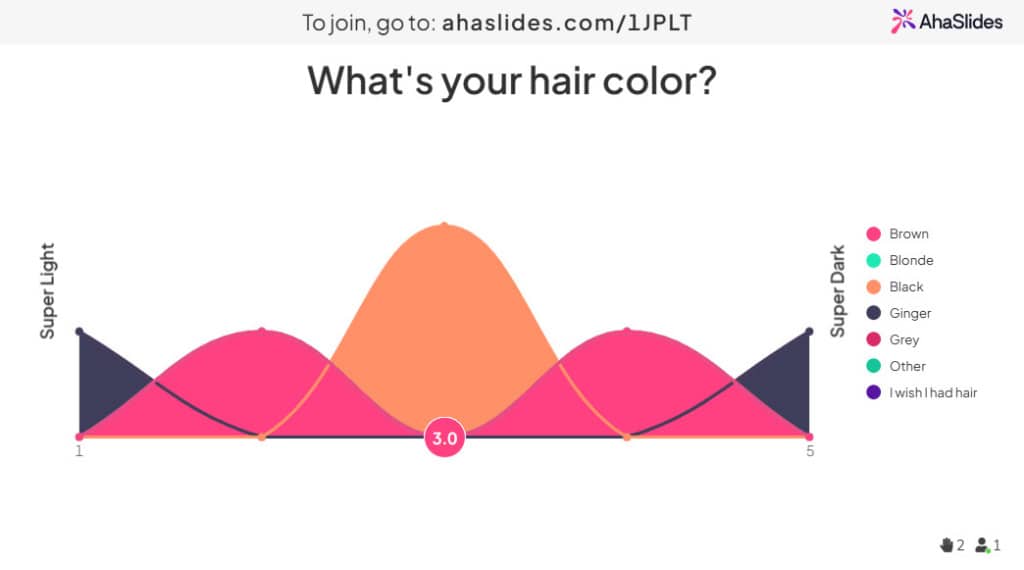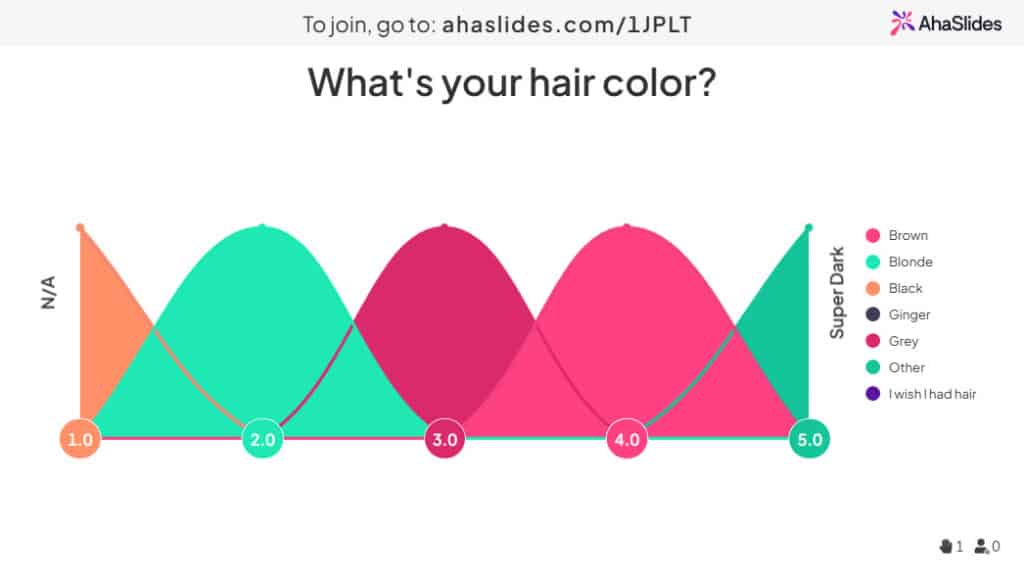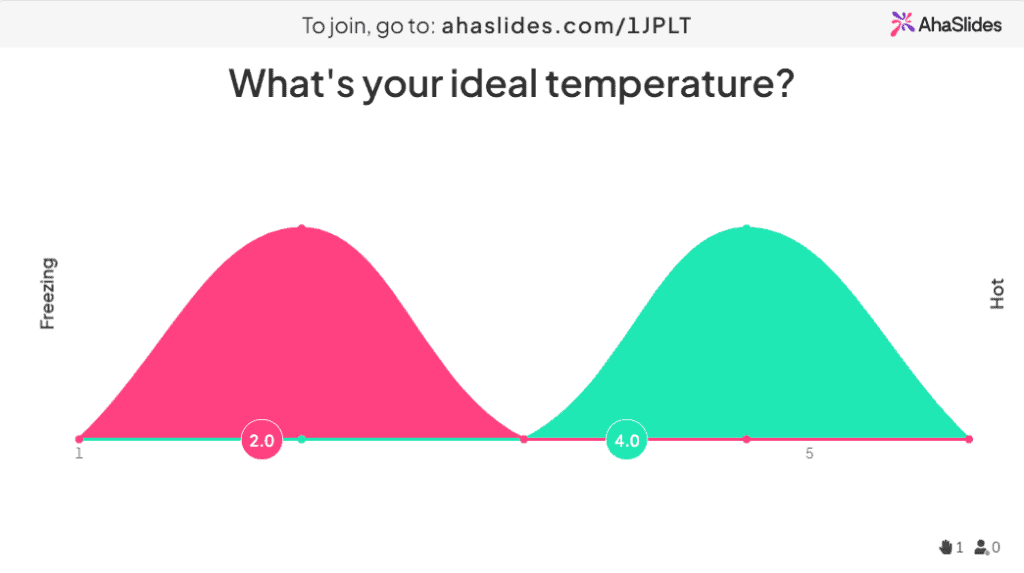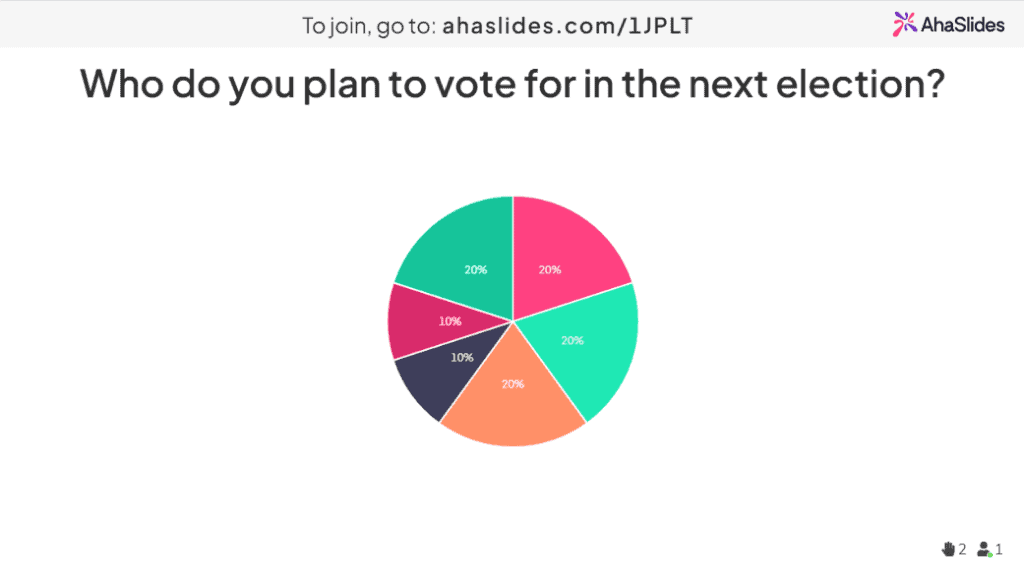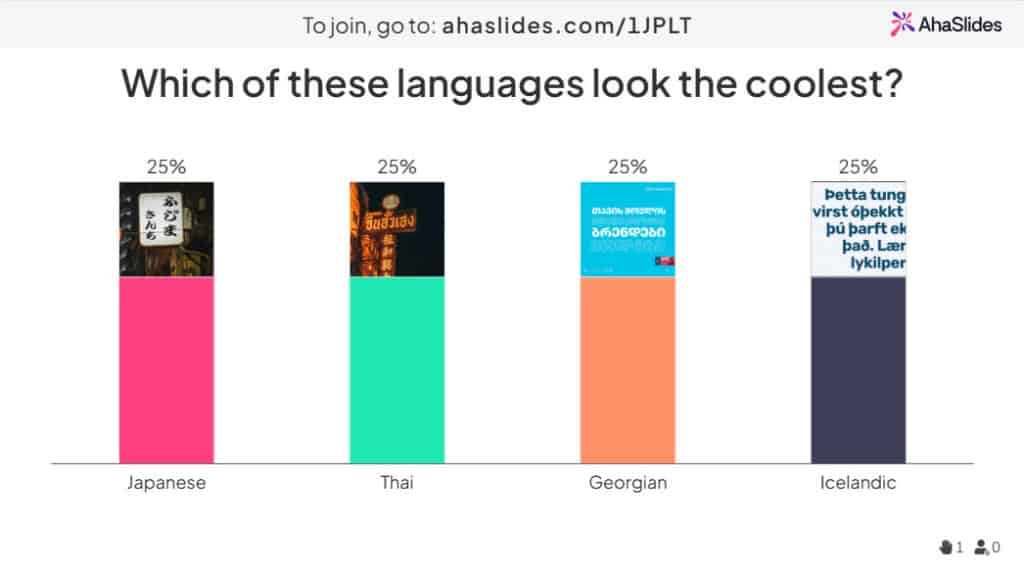In this business-centered world, it's no surprise that companies are constantly seeking ways to gain a competitive edge. From innovative marketing strategies to cutting-edge technology, businesses are always on the lookout for the next big thing that will set them apart from their competitors. With that, they have to satisfy the customers' ever-changing demands and expectations.
One way to easily identify what needs to be improved and addressed is through the customers' feedback. An ordinal scale is one method that can be used to measure customer satisfaction.
If it's your first time hearing about an ordinal scale, we've got you covered!
Below are 10 attractive and engaging examples of ordinal scale, all made on AhaSlides' free polling software!
Table of Contents
What is an Ordinal Scale?
An ordinal scale, also referred to as ordinal data, is a type of measurement scale that allows individuals to rank or rate items based on their relative position or preference. It provides a structured way to gather feedback and understand the customers' level of satisfaction with a product or service
Put simply, it is a statistical scaling system that operates with order. Usually, ordinal scales work on a 1 to 5 or a 1 to 10 rating system, with 1 representing the lowest value response and 10 representing the highest value response.
To get a clearer picture, let’s look at one super straightforward and common example: how satisfied are you with our services?

Chances are, you’ve seen this type of ordinal scale example before. It’s used to measure customer satisfaction on a 5-point scale:
- Very Unsatisfied
- Unsatisfied
- Neutral
- Satisfied
- Very Satisfied
Naturally, companies can use a satisfaction ordinal scale to determine if they need to improve their service. If they’re consistently scoring low numbers (1s and 2s) then it means action is much more urgent than if they were scoring high numbers (4s and 5s).
Therein lies the beauty of ordinal scales: they’re very simple and clear. With this, it is easy to gather and analyse data in absolutely any field. They use both qualitative and quantitative data to do this:
- Qualitative – Ordinal scales are qualitative because they focus on words that define a specific value. For example, people know what a satisfactory experience feels like, whereas it’s harder for them to define a ‘7 out of 10’ experience.
- Quantitative – They’re quantitative because each word corresponds to a number value. If an ordinal in research defines a satisfactory experience as a 7 or 8 out of 10 experience, then they can easily compare and chart all the collected data through numbers.
Of course, there are plenty of ordinal scale examples outside the satisfied/not satisfied response set. Let’s take a look at some of them….
10 Ordinal Scale Examples
Create any of the ordinal scales below for free with AhaSlides. AhaSlides lets you create an ordinal scale with questions, statements and values, then lets your audience input their opinions live using their mobile phones.
Type #1 – Familiarity
[Not at all Familiar – Somewhat Familiar – Moderately Familiar – Quite Familiar – Very Familiar]
Familiarity ordinal scales are used to check the level of knowledge that someone has about a certain topic. Because of this, they’re super useful for informing future advertising efforts, awareness campaigns and educational plans.
Some familiarity ordinal scale examples:
- A company testing its audience to see how familiar they are with certain products. The data that results from this can lead to advertising efforts towards products that scored lower familiarity.
- A teacher testing their students on familiarity of a certain subject. This gives the teacher an idea of what level of prior knowledge about that subject can be assumed before deciding where to start teaching it.
Need more live polls for the classroom? Check out these apps for teachers here!
Type #2 – Frequency
[Never – Rarely – Sometimes – Often – Always]
Frequency ordinal scales are used to measure how often an activity is performed. They’re useful for judging active behaviours and where to start changing them.
Some frequency ordinal scale examples:
- An ordinal survey gathering information about the degree to which the public is following rules. The data can be used to ascertain how well or how poorly a public information campaign is performing.
- A company gathering information about how a buyer is influenced on their website. The company can use this data to focus on certain types of more popular media, like video or banner ads, as opposed to other less-viewed media.
Type #3 – Intensity
[No Intensity – Mild Intensity – Medium Intensity – Strong Intensity – Extreme Intensity]
Intensity Ordinal Scales usually test the strength of a feeling or experience. This is often a hard metric to measure as it relates to something more conceptual and subjective than what is usually measured in ordinal scales.
Some Intensity Ordinal Scale examples:
- A medical establishment testing patients on their perceived levels of pain before and after treatment. The data can be used to determine the efficacy of a service or procedure.
- A church service testing churchgoers on the power of a sermon. They can use the data to see whether or not to sack their pastor.
Type #4 – Importance
[Not at all Important – Barely Important – A Little Important – Somewhat Important – Quite Important – Very Important – Essential]
Importance ordinal scales rate how non-essential or essential people find a product, service, sector, activity or pretty much anything to be. The results of this ordinal scale type are often surprising, so businesses should consider this type of scale to gain valuable insights about the perceived importance of their offerings. This information can help them prioritize resources and focus on areas that truly matter to their customers.
Some importance ordinal scale examples:
- A restaurant asking customers to put forward what is most important to them. Data from here can be used to figure out what parts of service need the most attention from management.
- A survey gathering opinions on attitudes to diet and exercise. Data can be used to find out how important the public sees certain aspects of keeping fit.
Type #5 – Agreement
[Strongly Disagree – Disagree – Neither Agree nor Disagree – Agree – Strongly Agree]
Agreement ordinal scales help to determine to what degree a person disagrees or agrees with a statement. These are some of the most widely used ordinal scale examples out there, as they can be used with any statement that you want a specific answer to.
Some agreement ordinal scale examples:
- A company surveying their customers about the usability of their website. They can make specific statements about what the company itself thinks and then see if their users agree or disagree with those statements.
- An employer gathering employee opinions about the workplace environment. Depending on the levels of disagreement and agreement to their statements, they can figure out what needs fixing for the benefit of the employees.
Type #6 – Satisfaction
[Deeply Dissatisfied – Dissatisfied – Somewhat Dissatisfied – Neutral – Somewhat Satisfied – Satisfied – Very Satisfied]
Again, this is a widely used example of an ordinal scale, as ‘satisfaction’ is the ultimate goal of businesses. All parts of a survey, in one way or another, try to gather information on satisfaction with a service, but satisfaction ordinal scales do this overtly and obviously.
Some satisfaction ordinal scale examples:
- A university gathering levels of satisfaction about their enrollment service. The data can help them determine what aspect needs improving the most for potential future students.
- A political party polling their supporters on their efforts over the past year. If their supporters are in any way dissatisfied with the progression of the party, they can start polling them on what they would like done differently.
Type #7 – Performance
[Well Below Standards – Below Expectations – About as Expected – Above Expectations – Really Exceeded Expectations]
Performance ordinal scales are very much like satisfaction ordinal scales, which measure the overall effectiveness and efficiency of a service. However, the subtle difference is that this type of ordinal scale tends to measure final performance in relation to someone’s predetermined expectations of that service.
Some performance ordinal scale examples:
- A company gathering customer reviews of each aspect of their purchase and delivery. They can use the data to see where the customers are placing high expectations and where the company is failing to meet them.
- A film studio trying to find out if their latest production lived up to the hype. If not, it’s possible either that the movie was over-hyped beforehand or that it failed to deliver, or both.
Type #8 – Likelihood
[Not at all – Probably not – Maybe – Likely – Certainly]
Likelihood ordinal scales are a great way to figure out how likely or unlikely a person is going to take a mentioned action in the future. This is often after certain conditions have been met, such as when a transaction or a medical procedure is completed.
Some likelihood ordinal scale examples:
- A company trying to determine what percentage of their customers will become advocates of the brand after using the service. This will reveal information that can help build brand loyalty across multiple channels.
- A medical survey for doctors determining the likelihood of them prescribing a certain type of medication after using it for the first time. The data will help pharmaceutical companies develop credibility for their drug.
Type #9 – Improvement
[Dramatically Worsened – Worsened – Stayed the Same – Improved – Dramatically Improved]
Improvement ordinal scales provide a metric on progress across a certain time period. They measure an individual’s perception of to what degree the state of affairs has worsened or improved after a change has been implemented.
Some improvement ordinal scale examples:
- A company asking for their employees’ opinions about which departments have worsened or improved in the past year. This will help them to make more meaningful efforts towards progress in certain areas.
- A climatologist conducting research into the public’s perception of climate change in the past 10 years. Gathering this kind of data is crucial to changing attitudes towards protecting the environment.
Type #10 – Self-Ability
[Complete Beginner – Beginner – Pre-Intermediate – Intermediate – Post-Intermediate – Advanced – Total Expert]
Self-ability ordinal scales can be very interesting. They measure someone’s perceived level of competence at a certain task, which means that they can vary wildly depending on the level of self-esteem that different respondents in a group have.
Some self-ability ordinal scale examples:
- A language teacher trying to determine how confident their students are in certain areas of language ability. The teacher can do this either before or after a lesson or course to determine improvement in self-perceived ability over time.
- An interviewer asking candidates about their own strengths and weaknesses during a job interview. Doing this can help single out the right candidate for the job.
Ordinal Scales vs Other Types of Scales

Now that we’ve had a thorough look at some ordinal scale examples, you might be wondering how the ordinal scale format differs from other scales.
Usually when we talk about ordinal scales, we talk about them in the same breath as the Four Scales of Measurement, which are:
- Nominal Scales
- Ordinal Scales
- Interval Scales
- Ratio Scales
Let’s take a look at how the ordinal scale examples we’ve just seen compare to the other 3 types of scale…
Ordinal Scale Example vs Nominal Scale Example
A nominal scale or nominal questions in a survey, is different from an ordinal scale in the way that its values have no order to them.
Here’s an example: I’m collecting some simple research data on hair colour. If I’m using a nominal scale, the values will simply be different hair colours (brown, blonde, black, etc.) Note that there’s no order here; it’s not like brown leads to blonde which leads to black and beyond.
Whereas if I’m using an ordinal scale, I can add values for the lightness or darkness of the hair, which does have an order (light leads to dark).
Here’s a nominal scale example about hair colour
And here’s an ordinal scale example about hair colour:
In this way, the ordinal scale example is giving us extra information. Not only does it reveal how many respondents of each hair colour we have (you can hover the mouse over any circular point to see how many responses it got), but we can also see the lightness or darkness of those hair colours on a 5-point scale between ‘super light’ (1) and ‘super dark’ (5).
Doing things the ordinal scale way is great for gathering another layer of information. However, you may run into a few issues where the nominal and ordinal values don’t match up. For example, how can a person with black hair also have ‘super light’ hair? And what value does a person with no hair choose?
You can address these issues with a couple of simple workarounds: One way is to leave a message for respondents that eliminates the chance of messing up the values:
- Another way is to leave the lowest value (1) as N/A (not applicable). Respondents who can relate to the nominal scale but not the ordinal scale can choose N/A to ensure that there’s no value conflict. The ‘super light’ value will therefore start on (2).
Ordinal Scale Examples vs. Interval Scale Examples
Just as an ordinal scale reveals more data than a nominal scale, an interval scale reveals even more than that. An interval scale is concerned with the degree of difference between the values. So, let’s see some interval scale examples and interval question examples.
So, let’s say I’m doing more simple research, this time into people’s ideal temperature at home and on holiday. In an ordinal scale format, I would set out my values like this:
- Freezing
- Cold
- Temperate
- Warm
- Hot
The big problem with this ordinal scale example is that it’s completely subjective. What’s considered ‘freezing’ for someone might be considered ‘temperate’ for someone else.
By virtue of the wording of the values, everyone will naturally gravitate towards the middle. This is where the words already suggest the ideal temperature, and it leads to a graph that looks like this:
Instead, I should use an interval scale, which will name the exact degrees in Celsius or Fahrenheit that correspond to each value, like so:
- Freezing (0°C – 9°C)
- Cold (10°C – 19°C)
- Temperate (20°C – 25°C)
- Warm (26°C – 31°C)
- Hot (32°C +)
Setting out the values this way means that my respondents can make their decisions based on an existing and well-known scaling system, rather than the biased perceptions of whoever wrote the question.
You can also get rid of the wording entirely so that respondents aren’t influenced by preconceived notions brought about by the strength of the words.
Doing this means that results are bound to be more varied and accurate, like this
Ordinal Scale Example vs. Ratio Scale Example
A ratio scale is similar to an interval scale in the way that it focuses on numbers and the differences between them.
The one big difference, however, is the presence in a ratio scale of the ‘true zero’ value. This ‘true zero’ is the complete absence of the value being measured.
For example, take a look at this ratio scale on work experience
You can see that this ratio scale example starts with the value of ‘0 years,’ which represents the complete absence of any work experience. This means that you have a solid, immovable foundation from which to begin your analysis.
Remember: not all zero values are ‘true zero.’ The 0°C value from our interval scale is not a true zero because 0°C is a specific temperature, not the absence of temperature.
Other Ways to Poll
Don’t get us wrong here; ordinal scales really are great. But to make a truly engaging survey in the fields of education, work, politics, psychology, or anything else, you’re going to want to branch out the format.
With AhaSlides, you’ve got heaps of ways to poll your audience!
1. Multiple Choice Poll
Multiple choice polls are the standard kind of poll and are available in bar, donut or pie chart form. Simply write down the choices and let your audience choose!
2. Image Choice Poll
Image choice polls work much the same way as multiple choice polls, just more visual!
3. Word Cloud Poll
Word clouds are short responses on a topic, usually one or two words long. The most popular answers amongst respondents appear in the centre in larger text, while less popular answers are written in smaller text outside the centre of the slide.
4. Open-Ended Poll
Open-ended poll helps you to gather answers with creativity and freedom. There’s no multiple-choice or word limit; these types of polls encourage long-form answers that go into detail.
The Perfect Online Polling Tool
Everything presented in this article — the ordinal scale examples, the nominal, interval and ratio scale examples, as well as the other types of polls, were all made on AhaSlides.
AhaSlides is a free digital tool that's super intuitive and flexible! It’s an online software that allows you to gather information and opinions from all over the world. You can leave your survey open, so that your respondents can take it without you even being there!
Through the ‘ rating scales’ slide, AhaSlides lets you create ordinal scales across a range of statements in 3 simple steps:
- Write your question
- Put forward your statements
- Add in the values
Your audience’s response data will remain on your presentation unless you choose to erase it, so the ordinal level data is always available. You can then share your presentation and its response data anywhere online. If you’d like to create your own ordinal scales, as well as a multitude of other types of polls, click the button below!
